|
|
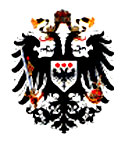 |
Dragon Society
Real History, Dragon Philosophy and
The Importance of Royal Bloodlines
from
TheDragonSociety Website
recovered though
WayBackMachine Website
|
Contents
The Dragon Society
Real History, Dragon Philosophy and
The Importance of Royal Bloodlines
Real
History
If you were bad at history when you were at school, do not despair!
Much of what your teachers tried to teach you was wrong!
A lot has been written, over the last decade or so, about recent
startling discoveries in European history, particularly in
connection with Christianity. We intend to present some of this
material in a simple, logical way. The section is called "Real
History" as although we may not be able to prove the conclusion
categorically, the one that is reached must be more accurate than
the one that we have been given for the last 2000 years.
There is also overwhelming evidence that information from a certain
organization can provide the conclusive proof that the theory
requires. The other reason for calling it "Real" (from the French)
is that it is essentially "Royal" history as the articles in this
section reveal.
Back to Top
The Dragon Society
Real History, Dragon Philosophy and
The Importance of Royal Bloodlines
Monarchy
by
Tracy R. Twyman
2003
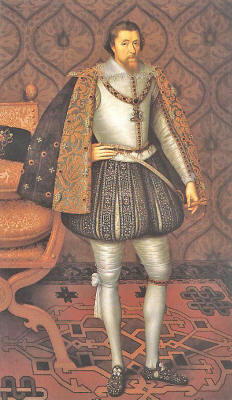
James VI of Scotland
James I of England
When the Stewart King James VI of
Scotland ascended the throne of England to become King James I of
Great Britain, he made a speech that shocked and appalled the nobles
sitting in Parliament. They had been waxing increasingly bold over
the last few years, attempting to limit the powers of the crown to
strengthen their own. What shocked them was that James used his
coronation speech to remind them of the ancient, traditional belief
that a monarch is chosen by God to be His emissary and
representative on Earth, and ought therefore to be responsible to no
one but God. In other words, James was asserting what has become
known to history as ‘The Divine Right of Kings’, and they didn’t
like it one bit.
Quotes from the speech show how inflammatory his
words actually were:
"The state of monarchy is the most
supreme thing upon earth, for kings are not only God’s
lieutenants upon earth, and sit upon God’s throne, but even by
God himself are called gods... In the Scriptures, kings are
called gods, and so their power after a certain relation
compared to divine power. Kings are also compared to fathers of
families: for a king is truly Parens Patriae, the politique
father of his people... Kings are justly called gods, for that
they exercise a manner of resemblance of divine power upon
earth: for if you will consider the attributes to God, you shall
see how they agree in the person of a king."
The nobles were aghast. This fat,
bloated pustule telling everyone to worship him as a god! It seemed
patently ridiculous. Even more offensive, James finished up his
speech by putting Parliament in its place basically telling them
that, since he ruled by the grace of God, any act or word spoken in
contradiction of him was an act against God himself. James
continued:
"I conclude then this point,
touching the power of kings with this axiom of divinity: that as
to dispute what God may do is blasphemy... so is it sedition in
subjects to dispute what a king may do in the height of his
power. I would not have you meddle with such ancient rights of
mine as I have received from my predecessors... All novelties
are dangerous as well in a politic as in a natural body, and
therefore I would loathe to be quarreled in my ancient rights
and possessions, for that were to judge me unworthy of that
which my predecessors had and left me."
Although it was James I that made the
concept famous, he certainly did not invent the idea of Divine
Right. The concept is, as we shall show, as old as civilization
itself.
As harsh and dictatorial as it may seem, such a system actually
protected the rights of individual citizens from even larger and
more powerful bullies such as the Parliament and the Pope. When
power rests ultimately in the hands of a single individual such as a
king, beholden to nobody except God, who need not appease anyone for
either money or votes, injustices are more likely to be righted
after a direct appeal to him. Furthermore, past monarchs who held
their claims to power doggedly in the face of increasing opposition
from the Catholic Church managed, as long as they held their power,
to save their subjects from the forced religious indoctrination and
social servitude that comes with a Catholic theocracy. Author
Stephen Coston wrote in 1972’s Sources of English Constitutional
History that:
"Without the doctrine of the Divine
Right, Roman Catholicism would have dominated history well
beyond its current employment in the Dark Ages. Furthermore, Divine Right made it possible for the Protestant Reformation in
England to take place, mature and spread to the rest of the
world."
The Divine Right practiced by European
monarchs was actually based on a more ancient doctrine practiced by
the monarchs of Judah and Israel in the Old Testament. Many European
royal families considered them to be their ancestors, tracing their
royal European lineage back to the Jewish King David, sometimes
through the descendants of Jesus Christ. Such a line of descent was
(and is) known as the "Grail Bloodline."
One of Europe’s most famous
monarchs, Charlemagne the Great, was often called "David" in
reference to his famous ancestor, and Habsburg King Otto was called
"the son of David." In fact, the European tradition of anointing
kings comes from that practiced in the Old Testament. Author George Athas describes how the ceremony symbolized the
Lord Yahweh adopting
the new king as his own son:
"Firstly, the king was the
‘Anointed’ of Yahweh - the mesiach, from which we derive the
term ‘Messiah.’ At his anointing (or his coronation), the Spirit
of Yahweh entered the king, giving him superhuman qualities and
allowing him to carry out the dictates of the deity. The
psalmist of Psalm 45 describes the king as ‘fairer than the sons
of men’, and continued to praise his majestic characteristics.
This king also had eternal life granted to him by Yahweh. The
deity is portrayed as saying to him, ‘You are my son - today I
have sired you.’ The king was Yahweh’s Firstborn - the bekhor -
who was the heir to his father’s estate. He was ‘the highest of
the kings of the earth.’ Thus, the king was adopted by Yahweh at
his coronation and, as such, was in closer communion with the
deity than the rest of the people. On many occasions, Yahweh was
called the king’s god.
The king was distinguished far above
the ordinary mortal, rendering him holy and his person sacred.
It was regarded as a grievous offence to lay a hand on him.
Thus, to overthrow the king was rebellion of the most heinous
sort and an affront to the deity who had appointed the king...
We can note that the King of Judah and Israel is described in
divine terms. He is, for example, seen as sitting at Yahweh’s
right hand, and his adopted son. We find similar motifs of
Pharaohs seated to the right of a deity of Egypt. Psalm 45:7
calls the king an ‘elohim’ - a god. Psalm 45:7also says ‘Your
throne is like God’s throne.’"
Here we see the basis for King James’
claim that the scriptures likened human kings to gods. As such,
kings were strongly associated with the priesthood as well, and in
some cases took on priestly functions. However, traditionally, the
Jewish priesthood was dominated by the Cohens of the Tribe of Levi,
which was biologically related but functionally separate from the
royal line of David - that is, until Jesus came along, heir to both
the kingly and priestly titles through his lineage back to both
tribes.
However, in other more ancient cultures, such as the
Egyptians, the royal and priestly functions were inseparable. In
addition to regarding their Pharaohs as the literal offspring of
deities, and in fact, deities themselves, the Egyptians believed
that the gods had given them the institution of kingship itself.
Their first king had been one of their main gods: Osiris, whom all
human kings were expected to emulate. Richard Cassaro, in his book,
A Deeper Truth, elaborates:
"... during the First Time [The
Golden Age when the gods ruled directly on Earth] a human yet
eternal king named Osiris initiated a monarchial government in
Egypt and imparted a wise law and spiritual wisdom to the
people. At the end of his ministry, Osiris left his throne to
the people. It was, thereafter, the duty of every king to rule
over Egypt in the same manner Osiris had ruled.
This concept that kingship began with a
single divine ruler of whom all subsequent human kings are
descendants can be traced back to the oldest civilization
acknowledged by history, Sumeria, and the other Mesopotamian
cultures that followed, such as the Assyrians and the Babylonians.
To quote Henri Frankfort:
"In Mesopotamia, the king was
regarded as taking on godhood at his coronation, and at every
subsequent New Year festival. However, he was often seen as
having been predestined to the divine throne by the gods at his
birth, or even at the beginning of time. Through a sacred
marriage, he had a metaphysical union with the mother goddess,
who filled him with life, fertility, and blessing, which he
passed onto his people."
The Encyclopedia Britannica has
identified three different types of sacred kingship that were
recognized in the ancient world. The king was seen as,
(1) the receptacle of
supernatural or divine power
(2) the divine or
semi-divine ruler
(3) the agent or
mediator of the sacred
However, this author believes it is safe
to say that all of these concepts stem from the almost universal
belief that kingship descended from Heaven with a single divine
being who was literally thought of as the ancestor of all those who
followed. This king, was known to the ancients as Kronos, the
Forgotten Father, and this is another name for the deity/planet,
Saturn. He was the ‘brightest star in the heavens", who fell to
Earth and intermarried with the wives of men to breed a race of
human kings (the Grail Bloodline). After that he was imprisoned in
the Underworld by his father, Zeus, the Most High God, for
disobeying a social taboo against interbreeding with humans, and
sharing secret knowledge with them.
Some might think this contradicts the
traditional association of ancient kings with the Sun-God, but in
fact, Saturn himself was a sun god of a sort. In ancient times
Saturn was the dominant figure in the night sky and as such became
known as ‘the midnight sun’ (a term later used by occultists to
refer to the Grail). From its position in the sky it appeared to
stand still, as the rest of the night sky revolved around it. It was
therefore also called ‘The Central Sun.’
Interestingly, although this theory of mine has long been in the
works, I’ve recently stumbled across an author named David Talbott
who shares this hypothesis on the origin of kingship. From a piece
on
his website, entitled "Saturn as a Stationary Sun
and Universal Monarch’, we read:
"A global tradition recalls an
exemplary king ruling in the sky before kings ever ruled on
earth.
This mythical figure appears as the first in the line of kings,
the father of kings, the model of the good king. But this same
figure is commonly remembered as the central luminary of the
sky, often a central sun, unmoving sun, or superior sun ruling
before the present sun.
And most curiously, with the rise of astronomy this celestial
‘king’ was identified as the planet Saturn."
One can see traces of this ancient
progenitor of kings just in the word ‘monarchy’ itself. The syllable
"mon" means "one" in Indo-European language systems, as in "The One
King Who Rules Over All." But in Egypt, "Mon" was one of the names
of the sun god, (also called Amun-Re) in its occluded state, at
night, when the sun, as they saw it, passed beneath the Earth. The
word meant literally for them, "The Hidden One", because he ruled
the world (and the Underworld) from his secret subterranean prison.
The syllable "ark" comes from the Greek "arche", meaning "original",
or "originator." As the first "monarch", Kronos was the originator
of kings, the Forgotten Father of all royal bloodlines. Many of our
commonly associated symbols of kingship date back to the time when
Kronos first introduced it, and are directly derived from him.
For instance, the crown symbolizes the
(central) sun, the "Godhead" descending upon the brow of the wise
king. The Sumerian kings adorned their crowns with horns, just like
Kronos was believed to have done. The throne was Kronos’ seat on his
celestial boat in heaven, and has also been passed down to us.
Kronos and his descendants were known as Shepherd Kings, an
appellation used by royalty throughout history, and this is the
origin of the king’s scepter, which was once a shepherd’s staff. The
coronation stone and the orb surmounted by a cross are also Saturnian/solar symbols, and the Egyptian word for the sun, Re, may
be the source of the French word for king, Roi.
Kronos, and the god-kings who followed him, were known by the title
"Lord of the Four Corners of the World." This has given birth to the
universal, recurring archetype of "Le Roi du Monde", a concept that
was brilliantly explored in a book by René Guenon of the same name.
In a surprising number of cultures throughout the world and
throughout history, there exists this concept of "The Lord of the
Earth", an omnipresent and eternal monarch who reigns from within
the very center of the Earth itself, directing events on the surface
with his superhuman psyche. In the Judeo-Christian tradition, "The
Lord of the Earth" is a term applied to Satan, or Lucifer, who, like
Saturn, was the brightest star in Heaven, but was cast down by
God.
Like Saturn, he was imprisoned inside the bowels of the Earth, in a
realm called Hell.
In fact, it is quite clear that the
figure of Satan comes from Saturn, the "Fish-Goat-Man", and
obviously the two words are etymologically related. Perhaps this is
why the "Grail Bloodline", the divine lineage from which all
European kings have come, is traced by many back to Lucifer. The
medieval Christian heretics known as
the Cathars took this concept
to its logical conclusion. They insisted that, since Satan is the
‘King of the World’ ("Rex Mundi’, as they called him), and
Jehovah
was, in the Bible, the one who created the world, Jehovah and
Satan must be one and the same. For preaching this they were massacred
unto extinction by the Papacy.
However, in the Eastern tradition, "the Lord of the Earth"
represents the ultimate incarnate manifestation of Godhood. They too
see him as ruling his kingdom from the center of the Earth, in a
subterranean city called either
Shamballah or Agartha. And in this
tradition, the Lord of the Earth is also a super-spiritual being
capable of incarnating on the surface of the Earth in a series of
‘Avatars’, or human kings who rule various eras of existence.
According to New Age author
Alice Bailey:
"Shamballa is the seat of the ‘Lord
of the World’, who has made the sacrifice (analogous to the
Bodhisattva’s vow) of remaining to watch over the evolution of
men and devas until all have been ‘saved’ or enlightened."
One of the names that the Hindus use for
"The Lord of the Earth" is Manu, who, writes
Guenon, is,
"a cosmic
intelligence that reflects pure spiritual light and formulates the
law (Dharma) appropriate to the conditions of our world and our
cycle of existence."
Author Ferdinand Ossendowski adds:
"The Lord of the World is in touch
with the thoughts of all those who direct the destiny of
mankind... He knows their intentions and their ideas. If they
are pleasing to God, the Lord of the World favours them with his
invisible aid. But if they are displeasing to God, he puts a
check on their activities."
These are obviously activities that
human kings, as incarnations of the Lord of the Earth, are expected
to replicate in their own kingdoms to the best of their ability. In
fact, a number of human kings throughout history have been viewed by
their subjects as incarnations of the "Lord of the Earth", embodying
the concepts that he represents. These include Charlemagne,
Alexander the Great (who was believed to have horns literally
growing from his head, just like Saturn), and Melchizedek, a
mysterious priest-king mentioned repeatedly in the Old Testament and
imbued with an inexplicable importance. He was called the "Prince of
Salem" (as in Jeru-Salem), and is said to have shared bread and wine
with Abraham on Mt. Moriah. Some believe that the cup which they
used is the artifact that later became known as the Holy Grail.
Some have also identified him with
another king of Jerusalem, Adonizedek, and with Shem, Noah’s son.
Nobody knows what his ancestry is, who his descendants might have
been, or why, thousands of years later, Jesus Christ was referred to
in the scriptures as, "A priest according to the Order of
Melchizedek."
Of Melchizedek’s significance, René Guenon writes:
"Melchizedek, or more precisely,
Melki-Tsedeq, is none other than the title used by
Judeo-Christian tradition to denote the function of ‘The Lord of
the World’...
Melki-Tsedeq is thus both king and priest. His name means ‘King
of Justice’, and he is also king of Salem, that is, of ‘Peace’,
so again we find ‘Justice’ and "Peace’, the fundamental
attributes pertaining to the ‘Lord of the World.’"
Even more pertinent information is
provided by René Guenon’s good friend Julius Evola, who in his book
The Mystery of the Grail wrote:
"In some Syriac texts, mention is
made of a stone that is the foundation, or center of the world,
hidden in the ‘primordial depths, near God’s temple. It is put
in relation with the body of the primordial man (Adam) and,
interestingly enough, with an inaccessible mountain place, the
access to which must not be revealed to other people; here
Melchizedek, ‘in divine and eternal service’, watches over
Adam’s body. In Melchizedek we find again the representation of
the supreme function of the Universal Ruler, which is
simultaneously regal and priestly; here this representation is
associated with some kind of guardian of Adam’s body who
originally possessed the Grail and who, after losing it, no
longer lives. This is found together with the motifs of a
mysterious stone and an inaccessible seat."
Clearly, that foundation stone of the
world is the same as the Black, or Hidden Sun in the center of the
Earth, or the ‘Grail Stone’ which is said to be hidden in that
location. The Grail Romances provide us with much insight into the
‘King of the World’ concept. He is represented in the story by one
of the supporting characters, Prester John, a king who is mentioned
in passing as ruling over a spiritual domain in the faraway East,
and who, quite fittingly, is said to come from Davidic descent.
Evola continues:
"The Tractatus pulcherrimus referred
to him as ‘king of kings’ rex regnum. He combined spiritual
authority with regal power... Yet essentially, ‘Prester John’ is
only a title and a name, which designates not a given individual
but rather a function. Thus in Wolfram von Eschenbach and in
the Titurel we find ‘Prester John’ as a title; the Grail, as we will
see, indicates from time to time the person who must become
Prester John. Moreover, in the legend, ‘Prester John’ designates
one who keeps in check the people of Gog and Magog, who
exercises a visible and invisible dominion , figuratively,
dominion over both natural and invisible beings, and who defends
the access of his kingdom with ‘lions’ and ‘giants.’ In this
kingdom is also found the ‘fountain of youth.’"
"The dignity of a sacred king is
often accompanied by biblical reminiscences, by presenting
Prester John as the son or nephew of King David, and sometimes
as King David himself... ‘David, King of the Hindus, who is
called by the people ‘Prester John’ - the King (Prester John)
descends from the son of King David."
The "Lord of the Earth", or
the figures that represent him, are often symbolized by a victory
stone, or a foundation stone which is emblematic of their authority.
For instance, British kings are crowned on the "Stone of Destiny",
believed to have been used as a pillow by Jacob in the Old
Testament. Such a stone is often referred to in mythology as having
fallen from Heaven, like the Grail Stone, which fell out of
Lucifer’s crown during his war with God, and became the foundation
stone for the Grail kingdom, having the power, as it is written, to
‘make kings.’ Because it fell from Heaven, the Grail is also often
associated with a falling star, like that which Lucifer represents.
Of course the Black Sun in the center of the Earth also represents
Rex Mundi‘s victory stone. It is interesting, then, that in the
Babylonian tongue, the word "tsar" means "rock", and is not only an
anagram of "star", but a word that in the Russian language refers to
an imperial monarch.
Sometimes the monarchial foundation
stone is represented as a mountain, especially the World or
Primordial Mountain that in mythology provides the Earth with its
central axis. The Sumerians referred to this as Mt. Mashu. Its twin
peaks were said to reach up to Heaven, while the tunnels and caves
within it reached down to the depths of Hell.
Jehovah in the Bible,
sometimes called El Shaddai ("The Lord of the Mountain") had Mt.
Zion for a foundation stone, and was believed to actually live
inside of the mountain. Later, the kingdom of Jesus Christ was said
to be "founded upon the Rock of Sion".
The stone that fell from Heaven, the royal victory stone, is also
sometimes depicted under the symbolic form of a castrated phallus,
such as that of Kronos, whose disembodied penis was hurled into the
ocean, and there spawned the Lady Venus. This story is a
recapitulation of the Osiris story, as well as the inspiration for
the Grail legends, in which the Fisher King is wounded in the
genitals, causing the entire kingdom to fall under a spell of
perpetual malaise. The only thing that can heal the king, and
therefore the kingdom is the Grail. This is a recurring theme in
world mythology. The king and/or the kingdom that temporarily falls
asleep or falls under a magic spell which renders it/him ineffectual
for a time, until the stars are right, or the proper conditions are
met. This causes the king and his kingdom to reawaken, to rise from
the ashes, from the tomb, or often, to rise out of the sea.
The cycle recurs in the tales of the
Lord of the Earth, who alternates between periods of death-like
sleep within his tomb in the center of the Earth, and rebirth, in
which he once again returns to watch over his kingdom, to restore
righteousness and justice to the land. He then presides over a new,
revitalized "Golden Age".
Julius Evola writes of the archetype:
"It is a theme that dates back to
the most ancient times and that bears a certain relation to the
doctrine of the ‘cyclical manifestations’ or avatars, namely,
the manifestation, occurring at special times and in various
forms, of a single principle, which during intermediate periods
exists in an unmanifested state. Thus every time a king
displayed the traits of an incarnation of such a principle, the
idea arose in the legend that he has not died but has withdrawn
into an inaccessible seat whence once day he will manifest, or
that he is asleep and will awaken one day... The image of a
regality in a state of sleep or apparent death, however, is akin
to that of an altered, wounded, paralyzed regality, in regard
not to its intangible principle but to its external and
historical representatives.
Hence the theme of the wounded,
mutilated or weakened king who continues to live in an
inaccessible center, in which time and death are suspended....
In the Hindu tradition we encounter the theme of Mahaksyapa, who
sleeps in a mountain but will awaken at the sound of shells at
the time of the new manifestation of the principle that
previously manifested itself in the form of Buddha. Such a
period is also that of the coming of a Universal Ruler (cakravartin)
by the name of Samkha. Since samkha means ‘shells’, this verbal
assimilation expresses the idea of the awakening from sleep of
the new manifestation of the King of the World and of the same
primordial tradition that the above-mentioned legend conceives
to be enclosed (during the intermediate period of crisis) in a
shell. When the right time comes, in conformity with the
cyclical laws, a new manifestation from above will occur (Kalki-avatara)
in the form of a sacred king who will triumph over the Dark Age.
"...many people thought that the
Roman world, in its imperial and pagan phase, signified the
beginning of a new Golden Age, the king of which, Kronos,
was believed to be living in a state of slumber in the
Hyperborean region. During Augustus’ reign, the Sibylline
prophecies announced the advent of a ‘solar’ king, a rex a
coelo, or ex sole missus, to which Horace seems to refer
when he invokes the advent of Apollo, the Hyperborean god of
the Golden Age. "
Rene Guenon, Evola’s good friend,
believed in this concept, and that the periods of slumber for the
Lord of the Earth have been cyclically brought to a close by
apocalypses. After this, Le Roi du Monde would return to clean up
the wreckage and once more look after his faithful flock. In the
Revelation of St. John the Divine, three kings actually return from
periods of slumber, death, or prolonged absence: Jesus, Satan, and
Jehovah, and naturally, the governmental entity that God chooses for
this utopian world is the one which has always been associated with
holiness and righteousness: monarchy.
Monarchy was the first form of government observed by man, and it
was, according to almost every culture, created by God himself. It
is the primordial, archetypal form of government, the most natural,
that which all other forms of government vainly try to mimic, while
at the same time violating its most basic tenets. Monarchy was, for
thousands of years, all that man knew. The idea of not having a
monarch, a father figure to watch over them, to maintain the
community’s relationship with the divine, represented to them, not
freedom, but chaos, uncertainty, and within a short time, death. The
common people did not jealously vie for positions of power, nor did
they desire to have any say in the decision of who would be king. In
fact, most of them preferred that there be no decision to make at
all: most monarchies functioned on the principle of primogeniture,
passing the scepter and crown down from father to son, or in some
cases, through the matrilineal line. The decision was up to nature
or God, so therefore just and righteous in itself.
Furthermore, they knew they could count
on their king or queen to watch over them as they would their own
children, to be fair and honest, to protect them from invasion, to
maintain the proper relationship between God and the kingdom. They
desired to make their kingdom on Earth reflect the order and
perfection that existed in God’s kingdom in Heaven.
And for
thousands of years before the modern era, when 90% of the population
was not intellectually capable of participating in government or
making electoral decisions, monarchy stood as a bulwark against the
disintegration of the societal unit, providing a stability that
otherwise could not be achieved. If monarchy had not been invented,
human history could never have happened.
Richard Cassino, in A
Deeper Truth, said it best:
"Since the obligation of every
king... is to maintain law, order, morality, spirituality, and
religion within his kingdom, then the very design of a monarchy
itself was probably conceived by the superior intelligence
called God so as to endow mankind with a sound system of
government. In other words, the concept of kingship was designed
for, and delivered to, the peoples of earth by God to teach
mankind to live in a humanized social environment... Human
history, with its past and present kingdoms and kings - Egypt,
Assyria, Persia, Babylon, Sumer, Aztec, Inca, Jordan, Saudi
Arabia, Great Britain, to name a few - stands as a testimony to
the fact that the monarchial form of government has been the
basis for almost every civilization."
If monarchy is the most perfect form of
government, and if it has been responsible for providing us with at
least 6000 years of human history, why now does it seem to be only
an ancient pretension? Why is the concept of having a monarchy
actually function in government considered to be a quaint but
laughable thing of the past? Have we really moved beyond monarchy?
Hardly. If you were to graph the entire 6000 years of known human
history and isolate the period in which civilized nations have been
without monarchs, it would be merely a blip on the spectrum. In
fact, of the civilized Western nations, few do not have a monarch
reigning either de jure or de facto (although they continue to elect
Presidents from royal European lineage.) Most nations that maintain
representational government still have a monarch either recognized
by the government, or by the people at large. Although essentially
powerless, these monarchs maintain a symbolic link between a nation
and its heritage, its most sacred, most ancient traditions.
They also constitute a
government-in-waiting, should the thin veneer of illusory ‘freedom’
and ‘equality’ that maintains democracy break down. The modern
system of Republican government is based not so much on the freedom
of the individual, but on the free flow of money, on debt, usury,
and inflation, on a monetary house of cards known as "Fractional
Reserve Lending." It would only take a major and slightly prolonged
collapse of the monetary system to eliminate this governmental
system. At that point, civilized man will have essentially two
choices: anarchy or monarchy, and if people have any sense at all
they will choose the latter, rather than subjecting themselves to a
chaotic succession of despots interspersed with periods of violence
and rioting, and the poverty that comes with the lack of a stable
state.
It would be the most natural thing in
the world for the royal families of Earth, as well as the monarchial
system which they have maintained, and which has maintained us for
thousands of years, to just slide right into place. The kingdom of
the gods, who once ruled during man’s Golden Age, would awaken from
their slumber and heed the call to duty, like Kronos, their
Forgotten Father, and monarch of all, who soundly sleeps within his
tomb in the primordial mountain, waiting for his chance to once
again hold dominion over the Earth.
Back to Top
Back to The Black Nobility
The Dragon Society
Real History, Dragon Philosophy and
The Importance of Royal Bloodlines
The Code
of a Revolution
The Background
Many Christians in Europe and North America today feel that the
stories in the New Testament should not perhaps be taken as
literally as they were a few generations ago. Of course Darwin’s
theory of evolution has contributed much towards this. Also, in
industrial societies, we do not feel such a need to pray to God for
harvests, even though we may appeal to him for good weather for our
holidays as a kind of insurance policy. There are, of course, those
who take every word in the New Testament literally, and their
beliefs have to be respected.
However, we have to bear in mind that Palestine at the time of
Jesus
Christ was a country in chaos. Three thousand Jewish rebels were
crucified under the occupying power of the Romans after they had
assumed direct rule of the Jews in 6AD. Pontius Pilate was a cruel
and corrupt ruler who compounded the atrocities committed by his
predecessors. It is therefore surprising that there were no openly
anti-Roman writings in the Bible to relate these circumstances. Not
even such incidents as the burning of Rome by Nero were mentioned.
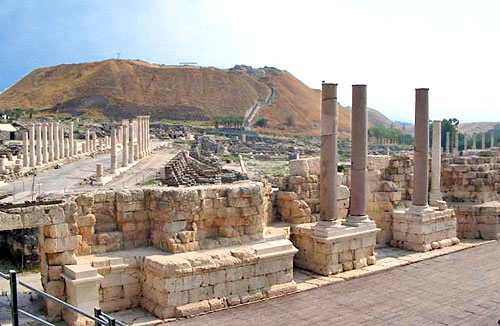
Beit She’an Roman Theatre, Israel
There was a bewildering array of active
Jewish sects and sub-sects at the time. Jesus Christ was a Jew, and
there is evidence that his sympathies were with the Jewish uprisings
organized by such groups. According to The Dead Sea Scrolls
Deception, Jesus Christ seemed to have connections with most of
them. It is difficult to differentiate among the various groups.
There were the Pharisees who, despite what is said in the Bible,
were anti-Roman, although rather more passively so than other sects.
The original Greek version of the Bible refers to
Jesus Christ as a
Nazarene. This was later wrongly interpreted to mean that he
came
from Nazareth. It is believed that the town of Nazareth did not
exist at the time of Christ’s birth as there is no contemporary
mention of it.
The sect, the Nazarines or Nazarites,
were certainly in existence at the time of Christ, and Christ’s
brother, James, and John the Baptist were both Nazarites. The modern
Arabic word Nasrini means Christian, and derives from the Hebrew
Nazrim, a plural noun that comes from the term Nazrie-ha-Brit which
means ‘Keeper of the Covenant’, a rank of the Essenes Community at
Qumran on the Dead Sea. The Nazorites were associated with the
Community of the Essenes in the time of the Gospels. The Essenes
were an austere mystical sect whose influence at the time is
underestimated. The Nazarites were an important sub-sect of the
Essenes.
It is highly probable that if Christ did not actually belong to the
community known as the Essenes, he was well-versed in their beliefs
and sympathized with them. The Essenes believed strongly in the
coming of the Messiah, descended from the line of David.
There was also a group called the Zealots. They were not an
independent sect, rather a group whose members originated from other
sects, and constituted the ‘strong-arm’ of the movement against the
Romans. Their activities would today be termed ‘terrorist’ and the
uprising of the whole of Judea against the Romans in 66 AD was the
result of their activities. Although the Jews were massacred by the
Romans after this revolt, the activities of the Zealots continued
unabated for another century after Jesus Christ’s death.
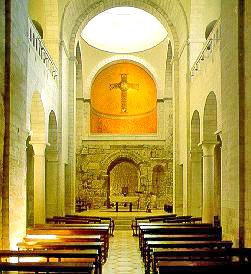
The Church of Ecce
Homo where Pilate allegedly judged Jesus
Even if Jesus Christ had not been a
Zealot himself, he was crucified as one. The two men who were
crucified with him certainly were Zealots. Jesus Christ embarrasses
the church by being reported as saying that he has come not to
"bring peace but a sword". He asks his disciples to purchase swords
[Luke 22:36], and checks that they have swords after the Passover
meal [Luke 22:38]. According to the fourth Gospel, Simon Peter is
carrying a sword when Jesus is arrested. In the context of the day,
these are surely the descriptions of a leader who is prepared for
and willing to take part in violence. Certainly Christ was executed
by the Romans in the way that they reserved for revolutionaries.
Jesus Christ had no intention of forming a new religion. The idea
that the Messiah was regarded as divine would have been preposterous
to the Jews. The Greek word for Messiah is ‘Christ’ or ‘Christos’,
and means anointed one, or king. When David became king, he was also
a ‘Messiah’ or ‘Christ’. When Jesus was born, he was also seen as
being the Messiah because of his Davidic pedigree. The Jews felt that
this new-born king would be the one who would deliver them from the
Romans.
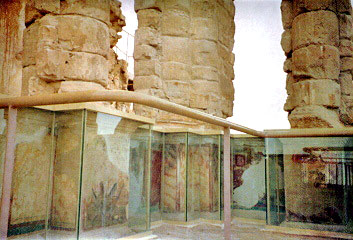
Herod’s Northern
Palace with 2000 year old frescoes
It is evident that the stories in the
New Testament are told in an allegorical way; in a code that would
be understood by some of the Jews and not by their Roman rulers.
Words that are used seem strangely unrelated to their actual
meanings, until, perhaps, we consider how certain terms have come
into the English language. We can say, for example, "He used to be
on the board, but now he is in the Cabinet." This, of course, does
not mean, "He used to be on a piece of wood, but now he is in the
cupboard."
These words and phrases (in Hebrew pershar in the singular,
persharim in the plural) had the same meaning each time they were
used. Additionally each time the meaning was required, the persharim
were used.
Before looking at some of the more familiar stories from the Bible,
here are some of the words used in the New Testament and the
explanation of what they really mean. The following explanations are
taken from the Persharim, the Manual of Discipline, the
Community
Rule and the Angelic Liturgy as quoted in
The Bloodline of the Holy
Grail.
for those with ears to hear
this was the signal that a statement that there would
follow a message that could be interpreted by those who
knew the code
Babylon
Rome
the word of God, the word
Jesus Christ
the lion
the Roman Emperor
the poor
those who had been initiated into the higher ranks of
the Community and had therefore had to give up their
worldly wealth
the many
the head of the celibate Community
the crowd
a designation of the regional Tetrarch (governor)
the multitude
the governing council
the children
the novices within the community
the Way
the doctrine of the Community
the Children of Light
those who followed the doctrines of "the Way"
leper
a person who has not yet been initiated into the higher
Community
the blind
those who did not follow the doctrine of "the Way"
the Power, the Kingdom, the Glory
the Priest, King and Prophet of the Community
The Loaves and the Fishes
The story of the loaves and fishes is an example of a parable. As an
example of how the coding was used to inform "those with ears to
hear" let’s look at one of the more familiar stories from the Bible,
and see how the code was used.
Gentiles who wanted to be baptized in the Judaic tradition were
referred to as "fishes". They were hauled out of the water into
boats by "fishermen" to be blessed by the "fishers" who were the
priests. Similarly, the Levite officials of the Sanctuary were known
as "loaves". In the ordination rite, the Levite priests would serve
seven loaves of bread to the priests and five loaves and two fishes
to the celibates. The Gentiles were allowed to receive baptism only
as "fishes" whereas only Jews could become "loaves".
At these ceremonies the "fishermen" would take their boats out into
the water, and the Gentile fishes, who were to be baptized, would
walk out into the water. When this had taken place, the priest
"fishers" would walk out into the water along jetties, and thus
"walking on water" to the boats. As Jesus had been born into the
house of Judah, and was therefore not a Levite, he was not entitled
to act as a baptismal priest, but he chose to disregard this
convention, and "walked on the sea" to the disciples’ boats.
One of the main aims of Jesus Christ’s philosophy was to bring the
"unclean" Gentiles together with the Jews, and furthermore to let
them take part in what had been reserved for the Jewish priesthood.
There was a group of uncircumcised Gentiles known as the "Five
Thousand", and Jesus granted the "multitude" (in other words, their
governing body) the serving of five loaves and two fishes that were
otherwise the reserve of the Jewish priesthood candidates.
None of this detracts from any skills Jesus Christ may have had as a
healer. However, it was not a healer that was predicted to arrive as
the Messiah. What differentiated Jesus from the others was that,
despite the feelings of such groups as the Pharisees, he extended
his medical expertise to the "unworthy" and "unclean" Gentiles, thus
illustrating his ideal of a united people against the authority of
the Romans.
Bibliography
Back to Top
The Dragon Society
Real History, Dragon Philosophy and
The Importance of Royal Bloodlines
The Greatest Fraud
by Nicholas de Vere
2003
The
Donation of Constantine first
appeared during the 8th century and was a document which purported
to recognize the Roman popes as Christ’s representatives on Earth
and to donate to Pope Sylvester and the Roman Church all those
Imperial powers formerly invested in the Throne of Byzantium.
The ’Donation’, the Church claimed, was written in the 4th century
at the insistence of the emperor Constantine. The Church said that
he was so grateful for having been cured of leprosy by Pope
Sylvester, that he gave into the Church’s hand the entire power and
wealth of the unified Roman Empire, including the right to crown and
dethrone kings. Now that is what you call expensive medical
insurance.
Supposedly written before 337 AD - the year of Constantine’s death -
the Donation of Constantine actually didn’t make an appearance on
the stage of European history until four hundred years later. So
far-reaching are the powers bestowed upon the Church by this
document, one would have thought that it would have been made public
at the time of its bestowal. Not centuries later.
The provisions of the Donation were enforced in 751 AD following
which
the Merovingians were deposed
by the Church and replaced by their sycophants, the Mayors of the
Palace who later became known as the Carolingians. The Church had
made a pact with the Mayors and offered to ’recognize’ their
legitimacy as rulers if they would dispense with the true Dragon
Kings. The deal was done and the Carolingians were made the puppet
rulers under the Roman Church.
The Donation, because it was made by a Dragon King, Constantine,
legitimized the Church’s right to take this action. To all intents
and purposes they had the authority of Dragon Kingship given up to
them by this Charter. No doubt the Merovingians knew this to be a
fraud, which is why they refused to recognize the authority of the
Church to meddle in affairs of state. What do we learn from this?
We can see from the Church’s choice of ’benefactor’ that the Church
was well aware that universally, only those of the Dragon Blood
would be recognized as true kings. Therefore they chose Constantine
as he was known to have been descended from both the Britannic PenDragon House and the
Dragon House of David. Furthermore he was a
member of the Desposyni - the heirs of the Lord - the blood
descendants and legitimate representatives of Jesus Christ. In the
Donation, it appeared as if Constantine had relinquished his
hereditary spiritual position as a Messiah and invested it in the
Papacy.
By suggesting they were the representatives of Christ, the popes
were claiming Dragon descent for themselves. It was well known that
Jesus
had descendants and that they were part of the only Eurasian
dynasty which was authorized to be kings - the Elven Overlords or
Dragons. It would have appeared to the public then, that in the
displacement of the Merovingians, one Dragon dynasty was being
replaced by another, albeit a paper one. This reduced any danger of
mass unrest. As time passed however, it became uncomfortably clear
that the function of kingship under the Merovingians had been
entirely different to that under the Carolingians. Whilst the
Merovingians had formerly assumed the role of overseers, sages and
wise counsellors, the Carolingians and their successors, prompted by
the Church, became deliberately poorly educated, ignorant,
insensitive tyrants and territorial tradesmen.
Dragon Kingship and the Grail Code had died to be replaced by a
corrupted form of feudal totalitarianism and brutal, economic
slavery as the Church carefully and strategically replaced the old
dynasties with its own merchant-class client families who, from that
day on, became
vassals of the Vatican.
Lastly we learn that from 751 AD the true Dark Age began in earnest.
The Elven Holocaust was initiated and would run its course for
another thousand years until, in England at least, the witchcraft
laws were repealed in 1736. North of the border in Scotland,
however, the persecution of witches in the 1700’s was at its
fiercest until the end of the century.
During this time, history has witnessed the rise of the Church of
Rome and its successful struggle for power. In time, no dynasty
ruled in Europe or remained in power unless the Church sanctioned
their reign. The Church chose the royal families, it crowned kings
and it deposed its detractors. In short, the Church, under the
auspices of the Donation of Constantine was the sole and supreme
temporal power in Europe and the known world. Without this purported
imperial benefice however, the Church would have remained a
marginalized Mediterranean cult contesting for patronage along with
a host of other gnostic Christian denominations.
The royal dynasties, sponsored by the Church and crowned by its
Divine Right, instituted their courts and parliaments, passed laws
and employed agents to act on their behalf. To all intents and
purposes it seemed as if the Church had the absolute right of
Dragons and wielded power by the very sanction of Jesus Christ and
God.
No monarch reigning today and no government under the monarch or
instituted in their name would enjoy their position if the Church,
empowered by the Donation, had not given them permission to rule in
the first place. Without the
Donation of Constantine, European
history today would be totally different and none of the dynasties
past or present would have had the right to have reigned. Nor would
they reign now and none of their governments or agencies would have
exercised power.
One slight problem, though. The Donation of Constantine is a
complete and utter fraud and the Church was never given any temporal
powers at all, let alone the right to found dynasties, crown kings
or institute governments. The whole document was a lie from
beginning to end and has been known to be a fake since Lorenzo Valla
applied the methods of historical criticism to it during the
Renaissance.
How do we know Valla was correct? The New Testament references
incorporated into the wording of the Donation were taken from the
Latin Vulgate version of the Bible. The Vulgate Bible was
compiled
by St. Jerome who was born more than two decades after Constantine
was supposed to have signed the Donation. The actual Vulgate Bible
wording that appears in the Donation didn’t exist until St Jerome
invented it, fifty years after the document had supposedly been
dated and signed by the Emperor. By this time Constantine had been
dead for decades and couldn’t have signed the Dragons’ rights away
anyway.
The language of the Donation is eighth century clerical or dog
Latin, whilst the Latin used in the 4th century Empire was late
classical Roman. The Imperial and Papal ceremonials described in the
Donation didn’t exist in Constantine’s time but were developed some
centuries later.
Several documentary instances of the Church’s use of the Donation to
assert their authority in the medieval period still exist, including
the letter of Pope Gregory IX entitled ’Si Memoriam Beneficiorum’
dated October 23rd 1236 and addressed to the Emperor Frederick II.
Pope Gregory writes,
".......that as the Vicar of the
Prince of Apostles (the Roman Pope) governed the empire of
priesthood and of souls in the whole world, so he should also
reign over things and bodies throughout the whole world; and
considering that, he should rule over earthly matters by the
reins of justice to whom - as it is known - God had committed on
earth the charge over spiritual things. The Emperor Constantine
humbled himself by his own vow and handed over the empire to the
perpetual care of the Roman Pontiff with the Imperial Insignia
and sceptres and the City and Duchy of Rome........".
People in the medieval and Renaissance
period, confronted with this document, did not generally criticize
the Donation on the grounds of its veracity. They just exclaimed
aghast that they could not believe that Constantine would have been
stupid enough to have given the Roman Church everything.
From the Donation we understand that Constantine offered the
Pope
all the robes and Crowns of office but the Pope, being such a humble
man, gave them back to the Emperor. This lets the Church off the
hook should some malcontent turn up and ask for sartorial evidence.
If the readers read the Donation for themselves they will be
appalled at the pretentious egotism, the arrogance and the sheer
material greed of the Church, as authors of the document.
The fraudulent imperial power of the Vatican to create kings by
’coronation’ - derived from this faked 8th century ’Donation of
Constantine’ - was later adopted by the Archbishops of the Church of
England with the complicity of the Tudors, who were Catholics
themselves.
When he split with Rome, Henry VIII still retained and later
ratified and re-established in the Anglo-Catholic Church of England
the fraudulent right of the Church’s clergy to create by coronation,
a succession of British monarchs. This was an illegal act. The ’Donation of Constantine’ was proved to be a completely fake
document. Therefore no Royal Elven House that knew its origins and
cared about social justice could possibly bring itself to recognize
a Christian British monarchy or any of their Church sponsored,
Church crowned predecessors or any of their regnant or formerly
regnant, European cousin Houses.
Because the Donation was a fraud and no subsequent priest of any
Catholic derived denomination ever had the right to crown kings,
Britain has had no legally reigning monarch for 900 years. As a
consequence of this, all the laws passed by these monarchs were and
are illegal and worthless and all the governmental agencies set up
by or derived from these monarchs or their laws are also illegal and
worthless up to the present day.
When considering this, the reader might like to consider the fact
that all the arrests ever made by the police in Britain and Europe
are acts of kidnap and habeas corpus. Equally, any man who
has taken up arms for the Crown and killed for his country is
unprotected by law and guilty therefore of murder.
However, paradoxically, as the entire British legal system is
illegal, there are no laws, and so the crimes of habeas corpus
and murder as we define them today, simply do not exist.
Subconsciously people know that their politicians and monarchs have
no legitimate authority to rule over them. They manifest this
knowledge in an increasing disrespect for these optional, arbitrary
and illusory social conventions, which is yet another reason why
social order is breaking down.
If the UN is right, we may face chaos in the near future; and all
because of a stupid fraud, perpetrated by a group of myopically
greedy, maniacal peddlers of false religion who are now long dead.
Again, for asserting this kind of view the Fairies are implicitly
guilty of Treason, even though all British laws are constitutionally
illegal and the act of treason itself is a non sequitur. Think of
the implications of this.
It applies to any nation state in the Christian world today which is
still a monarchy or which has evolved as part of a successive,
developing political process originating from a monarchy, by virtue
of its continuing sanction from, or sponsorship by, the Church of
whatever denomination. It is unauthorized by any temporal or divine
power to coerce anyone to obey any law originating at any stage of
that government’s evolution.
In effect, Britain, Europe and America are ruled by the sword, and
that sword is being wielded by people who are no more than short
sighted, self seeking robber barons. They have no constitutional
right to rule even in America, where in the 19th century, the
libertarian commentator, Lysander Spooner, demonstrated that the
consensual nature of the original document, upon which the
subsequent, consecutive clauses are founded, was being flouted,
thereby making the entire Constitution illegal. Pierre Proud’hon
called them all "Tyrants and Usurpers". Next time you are tempted to
eulogize Western Democracy, bite your tongue and let your brain
select first gear before you open your mouth. Flawed or otherwise,
the idea that the English speaking world has any democracy at all is
a joke.
At the beginning of this work the author stated that the people have
been conned enough. He now hopes that the readers might appreciate
for themselves the precise extent to which the people have actually
been deceived. They have accepted a state of affairs where they and
their ancestors have been enslaved by a chameleon-like corporate
body that has destroyed their creativity and robbed them of their
psychological liberty and their freedom of conscience for over a
thousand years.
The entire moral basis of our society is founded upon a massive
historical lie which has twisted the minds of generations of
individuals until they have become terrified of the natural drives
of their own bodies and souls.
The resultant taboos that have been created have been used to divide
the minds of the people and make them dependant on the Church-State
for solutions to the problems of resisting Satan and fighting
temptation and sin, when these contrived, nonsensical whimsies never
existed in the first place.
As a result, western Christian society was turned into an open air
lunatic asylum packed full of lost souls who weren’t lost at all and
had no need of a cure for diseases of the soul they weren’t actually
suffering from in the first place.
The Church created the confusion and the division and then offered
the solution. In fear the population invested its trust in the
perfidious Church and in return for their confidence the Church
turned the people into slaves and an entire civilization into a
manufacturing plant to service their own greed for luxury and power.
For a thousand years the Fairies have remained silent about their
identities - formerly for fear of their lives - latterly for fear of
becoming social outcasts and objects of mirth and derision. Still
however, a shadow of menace lies over the ancient families. Greed
will go to any length to ensure the continuity of its satisfaction
and the same motives that prompted the Church to murder and lie in
the past, still prompt their merchant-class puppets to kill and
deceive today.
Back to Top
The Dragon Society
Real History, Dragon Philosophy and
The Importance of Royal Bloodlines
The Discovery
Rennes-le-Château is a village situated on a mountain peak 25 miles
from Carcassonne in southern France. A few miles away there is
another mountain called Bézu on which there stand the ruins of a
former centre of the Knights Templar. About a mile east from Rennes-le-Château
are the ruins of the castle of the Blanchefort family, and the home
of Bertrand Blanchefort, the fourth grandmaster of the Knights
Templar.
The Knights Templar are the so-called Warrior Monks who
were proclaimed by Pope Innocent II in a Papal Bull in 1139 to owe
allegiance only to the Pope, and were therefore under no obligation
to kings and princes. Effectively they constituted an autonomous
international empire.
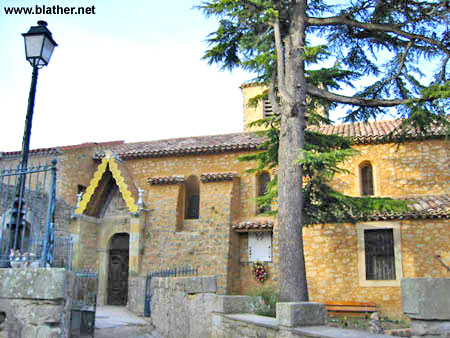
The church at Rennes-le-Château
Bérengere Saunière, the priest of
Rennes-le-Château,
decided to partly renovate the church the village church in 1891. It
had been consecrated to Mary Magdelene in 1059, and was built on the
site of a Visigoth church that dated back to the sixth century. When
the altar stone was removed, Saunière found that one of the pillars
that it stood on was hollow. Inside this column were four parchments
kept in two sealed wooden tubes. Two of them were apparently
genealogies. One dated from 1244, and the other from 1644. The two
others had been written in Latin by one of Saunière´s predecessors,
Abbé Antoin Bigou, who had been personal priest to the Blanchefort
family – important landowners in the area.
These parchments dated from the 1780s,
and seemed to be written excerpts from the New Testament in Latin.
However, in one of the parchments, the words were written without
spaces and extra, at first sight, unnecessary letters had been
added. In the second parchment, some letters had been raised above
the others. The following decipherment has appeared in French
documents written about Rennes-le-Château, and the book
The Holy
Blood and the Holy Grail by Michael Baigent, Richard Leigh and
Henry
Lincoln, and the BBC films that they made on the subject.
BERGERE PAS DE TENTATION QUE POUSSIN
TENIERS GARDENT LA CLEF PAX DCLXXXI PAR LA CROIX ET CE CHEVAL DE
DIEU J’ACHEVE CE DAEMON DE GARDIEN A MIDI POMMES BLEUES
which translates as:
SHEPHERDESS, NO TEMPTATION THAT
POUSSIN, TENIERS, HOLD THE KEY; PEACE 681, BY THE CROSS AND THIS
HORSE OF GOD I COMPLETE - or DESTROY - THIS DAEMON OF THE
GUARDIAN AT NOON, BLUE APPLES
Rather more obvious in the second
parchment is the following, spelled out in raised letters:
A DAGOBERT II ROI ET A SION EST CE
TRESOR ET IL EST LA MORT
which translates as:
TO DAGOBERT II, KING, AND TO SION
BELONGS THIS TREASURE AND HE IS THERE DEAD
Saunière realized that he had stumbled
upon something important, and therefore took the parchments to the
Bishop of Carcassonne. He was immediately ordered to go to Paris, at
the Bishop’s expense, where he met various important ecclesiastic
authorities. During the three weeks that he spent there, Saunière
was accepted into the circle of Émile Hoffet, the nephew of the
Director General of the Seminary of Saint Sulpice. Hoffet was
training for the priesthood, and was a well-respected scholar of
linguistics, cryptography and palaeography. He was also involved in
esoteric, occult groups, which included the writers Stéphane
Mallarmé and Maurice Maeterlink, as well as the composer
Claude Debussy. The famous opera singer, Emma Calvé, also mixed in these
circles, and is reputed to have had an affair with Saunière, or at
least a very close friendship with him. While there, Saunière bought
reproductions of three paintings from the Louvre, one of which was
Les Bergeres de Arcadie - The Shepherds of Arcadia by Nicolas Poussin.
When he returned to Rennes-le-Château, he continued renovations on
the church, and he discovered a burial chamber in the church that,
it is said, contained skeletons. He also turned his attention to the
sepulchre of Marie, Marquise d’Hautpol de Blanchefort. This had been
designed by Abbé Antoin Bigou, and the rearranged letters on the
inscription formed an anagram of the code above referring to
Dagobert II. Saunière, for no explained reason, obliterated the
inscription, but did not realize that it had been copied elsewhere.
He developed the habit of wandering around the countryside with his
housekeeper, Marie Denarnaud, collecting stones and rocks. He was
also in correspondence with people all over the world, and spending
a large amount of money on postage alone. Needless to say, this was
abnormal behaviour for a humble priest in the French countryside.
He was extravagant in many other ways too. A road was built leading
up to the village, and the Tower of Magdala was built. A new house
was built – Villa Bethania - which Saunière never occupied. The
church was decorated in an opulently bizarre way. Over the porch was
put the inscription:
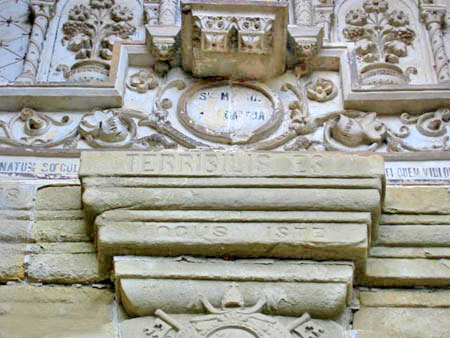
TERRIBILIS EST LOCUS ISTE
which translates as:
THIS PLACE IS TERRIBLE
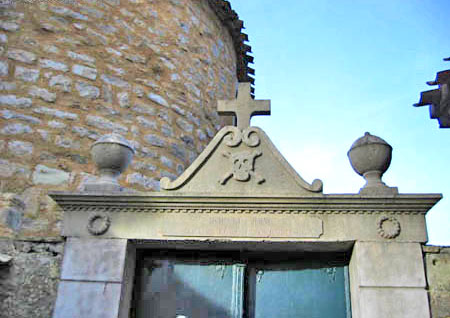
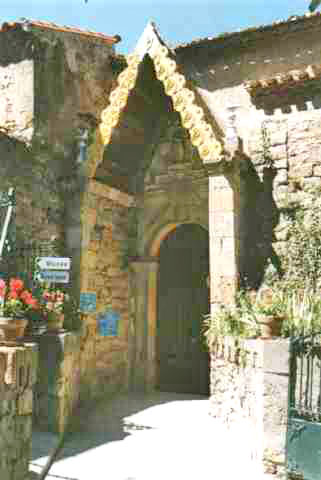
The church door
at Rennes-le-Château
Tracy Twyman points out in Dagobert’s
Revenge,
"this is a quote from Genesis, where Jacob falls asleep on a
stone and has a vision of a ladder leading up to heaven, with angels
ascending and descending. This, of course, is the same Stone of
Destiny brought to Scotland by Joseph of Arimathea, and became the
stone upon which British monarchy are crowned, even today. What’s
noteworthy is that beneath the words ’This Place is Terrible’
seems to be completed by the words in Latin ’but this is the House of God
and the Gateway to Heaven’, making it not a curse, but a statement
upon the dual nature of divinity."
Immediately inside the entrance to the church,
Sauniere placed a
statue of the demon Asmodeus - the demon in charge of secrets,
guardian of hidden treasure and, according to Judaic tradition, the
builder of the Temple of Solomon. He was also known as "the
Destroyer", as well as "Rex Mundi", the "Lord of the Earth." Inside
the church garishly painted Stations of the Cross were painted, and
in some there are inconsistencies. For example:
-
in Station VIII there
is a picture of a child dressed in Scottish tartan.
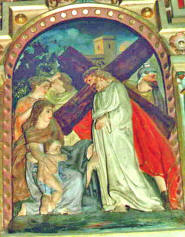
-
Station XIV
depicts Jesus’ body being carried at night under a full moon in the
vicinity of a tomb. It could mean that his body was being carried to
the tomb at night, several hours after the Bible would have us
believe. Or perhaps the body is being carried out of the tomb...
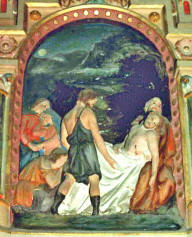
There are statues of five saints whose initials spell out
G.R.A.A.L.
(as in Holy Grail):
-
Saint Germain
-
St Roch
-
St Anthony de Padoue
-
St Anthony the Hermit
-
St Luke
In the shape of an "M". This "M"
has been supposed, for reasons that will later become apparent, to
stand for "Magdelene".
Reference is also made for the first time by Tracy Twyman in
Dagobert’s Revenge that,
"the church wall featured the
telltale marking, a yellow stripe embedded in the foundation,
which was used in those days to indicate that as early as the
8th century someone of royal blood was buried inside the
church."
And Saunière continued to spend. He had
a magnificent library installed in the Magdela Tower that he had
constructed, he built an orangery and a zoological garden and
accumulated valuable collections of china, fabrics and antiques. His
parishioners were treated to huge banquets and received visits from
various well-connected figures.
The most noteworthy of his visitors
was Archduke Johann von Hapsburg, a cousin of Franz-Josef, emperor
of Austria. According to banking records, the Archduke paid
considerable amounts of money over to Saunière.
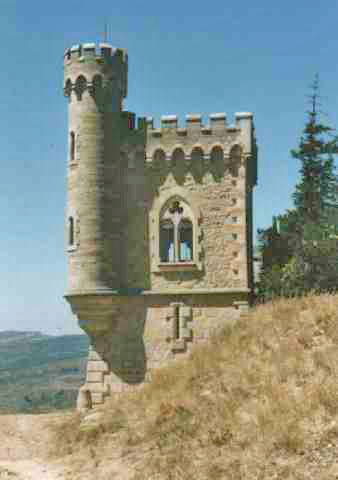
The Tower of Magdela
Although the church turned a blind eye
to these goings-on, it reached a point when the bishop of Carcassonne had to act, and he summoned
Saunière to make an account
of himself and his dealings. He accused Saunière of simony, that is,
the selling of masses. Saunière flatly refused to reveal anything,
and the Bishop therefore suspended him. However, Saunière appealed
to the Vatican, and he was re-instated.
Then on January 17th, 1917, at the age of 65, Saunière had a sudden
stroke. The date is of interest. It is the same date as the death of
Marie, Marquise d’Hautpol de Blanchefort, whose tomb inscription
Saunière had obliterated. It is also the feast day of Saint Sulpice
who crops up again and again in this account.
Of particular significance, however, is that five days before his
death, on January 12th, Saunière appeared to his parishioners to be
in good health. But this was the day that his housekeeper, Marie Denarnaud, ordered his coffin. The priest who heard Saunière’s
deathbed confession, according to some, "never smiled again" and he
refused to give Saunière the last traditional Roman Catholic rites
of extreme unction.
Saunière died on January 22nd. His body was sat upright in an
armchair on the terrace of the Tour Magdala. He was dressed in an
ornate robe with scarlet tassels attached. One by one unidentified
mourners filed past his body, and some took a tassel off the robe.
Nobody has ever been able to explain this odd procedure.
To the astonishment of everyone, when the will was read, Saunière
was discovered to have died penniless. Shortly before his death, he
had transferred all his money to his housekeeper. It is possible
that she had been in charge of the money all along.
After the Second World War, the French government introduced a new
currency, and all citizens were obliged to exchange their old francs
for the new ones. Large amounts of money had to be accounted for in
order to trace "black" money saved by collaborators, tax-evaders and
the like. Marie Denarnaud would not reveal the source of her money,
and was to be seen later burning large amounts of cash in the garden
of the Villa Bethania. She eventually sold the house to Monsieur
Noël Corbu, and told him that before she died she would tell him a
great secret, which would make him not only very rich but also very
powerful. Unfortunately, much to the chagrin of Monsieur Corbu, on
January 29th, 1953, she, like Saunière, suffered a sudden stroke,
and was rendered speechless and prostate on her deathbed.
Where the money could have come from
The obvious question that springs to mind is where did Saunière’s
money come from? The village and the surrounding area had been the
centre of considerable activity from the time that the Celts
designated it to be a sacred site to the time when the Cathars were
persecuted in the 11th century.
There had been tales of hidden
treasure throughout this time, and the Cathars especially were
suspected of being the possessors of the "Holy Grail". The
Knights
Templar also were thought to have hidden treasure in the area, and
Bertrand de Blanchefort organized excavations there. The Merovingian
kings ruled much of modern France from the 5th to the 8th centuries,
and Dagobert II, who was one of them, married a Visigoth princess.
Rennes-le-Château was, at that time, one of the major centres of
the
Visigoths. The Visigoths themselves had considerable treasure
accumulated from their pillaging of Europe, and in particular most
of the wealth of Rome in 410 A.D..
Saunière could have discovered any of this, but the nature of the
treasure appears to one’s instincts to be more that of a secret.
Otherwise certain factors, such as the introduction he received to
the Parisian intelligentsia from Hoffet, and the intense interest
that the church took in the matter. It also doesn’t explain why the
priest refused to give Saunière the sacrament of extreme unction,
and why he was visited by, for example, the Archduke Johann Salvator
von Habsburg.
The Archduke renounced rights to his
titles in 1889, and was banished from the Austrian Empire. Treasure
of "mere" monetary worth would also not explain the codes in the
parchments and on the tomb of Marie, Marquise d’Hautpol de
Blanchefort. Also Marie Denarnaud said that the secret she took with
her to the grave involved not only money, but power. The money that
Johnann Salvator von Habsburg paid over to Saunière came perhaps
from another source. The Vatican treated Saunière very carefully in
the latter years of his life. Could it be that the money came from
the Vatican in order to silence him?
The Mystery Deepens
When The Holy Blood and the Holy Grail first came out, the authors
received a letter form a retired Anglican priest who claimed that he
had "incontrovertible truth" Jesus Christ
did not die on the cross
and could have lived to as late a date as 45 A.D..
On being
interviewed, he claimed that he had been told the information by
another Anglican priest, Canon Alfred Leslie Lilley. Throughout his
life, Lilley had maintained contact with the Catholic Modernist
Movement that was based at Saint Sulpice in Paris, and he had known
Émile Hoffet. The authors felt that this connection added
authenticity to his claim.
The French painter, Nicolas Poussin, also appears to play a rôle in
this account. He was visited in Rome by Abbé Louis Fouquet, the
brother of Nicholas Fouquet, the Financial Superintendent to Louis
XIV of France, in 1656. After the meeting the Abbé wrote to his
brother. Part of the letter reads:
"He and I discussed certain things,
which I shall with ease be able to explain to you in detail -
things that will give you, through Monsieur Poussin, advantages
which even kings would have great pains to draw from him, and
which, according to him, it is possible that nobody else will
ever be able to rediscover in the centuries to come. And, what
is more, these are things so difficult to discover that nothing
now on this earth can prove of better fortune nor be their
equal."
Nobody has been able to explain the
rather cryptic message in this letter, but the fact is that shortly
after receiving this letter, Nicholas Fouquet was imprisoned for
life in solitary confinement. It has been suggested that he was the
model for The Man in the Iron Mask. All his correspondence was
confiscated, and handed over to Louis XIV who read it only in
private. Louis XIV went to great lengths to buy Poussin’s painting,
Les Bergers d’Arcadie which he had hidden away in his private
apartments at Versailles.
You will recall that it is a copy of this
painting that Berenger Saunière buys at the Louvre during his visit
to Paris.
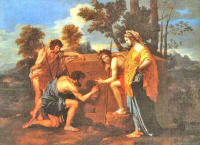
The painting depicts a large ancient tomb with three shepherds and a
shepherdess in the foreground. The setting is of a rugged landscape
that is typical of Poussin. The inscription on the tomb reads:
ET IN ARCARDIA EGO
The landscape had always been assumed to
be a product of the artist’s mind. However, in the 1970s, an actual
tomb was located which was identical in shape, dimensions,
vegetation, background and setting. There is even rocky outcrop that
is identical to that one which one of the shepherds rests his foot.
If you stand just in front of the tomb, you will see that the view
is exactly the same as the one in Poussin’s painting. The
corresponding peak in the background is that of Rennes-le-Château.
The tomb is located just outside a village called Arques, 6 miles
from Rennes-le-Château and 3 miles from the château of the
Blanchefort family. There is no indication of the age of the tomb.
The village records state that the land surrounding the tomb
belonged to an American who opened the sepulchre in the 1920s and
found it to be empty. He died in the 1950s and was later buried in
it with his wife.
Which brings us back to the inscription on the tomb in Poussin’s
painting. It appears to not make much sense, as it lacks a verb:
And in Arcadia I…
However, an anagram of the inscription
reads
I TEGO ARCANA DEI
which means:
BEGONE! I BEHOLD THE SECRETS OF
GOD
Perhaps the mayor of Rennes-le-Château
was correct when he said to Tracy Twyman last year, "This place is
the centre point of the world."
Now go to The Conclusion to read some of the conclusions that have
been reached.
Of course, a subject of this magnitude cannot be covered adequately
in an article of this length. We therefore recommend you to read The
Holy Blood and the Holy Grail by Michael Baigent, Richard Leigh and
Henry Lincoln from which we researched much of the information given
here.
Back to Top
The Dragon Society
Real History, Dragon Philosophy and
The Importance of Royal Bloodlines
The Conclusion
After painstaking research, the authors of
The Holy Blood and the
Holy Grail, Michael Baigent, Richard Leigh and
Henry Lincoln, reach
some fascinating conclusions about the Christian faith and western
history in particular. They do not attempt to maintain that these
conclusions are 100% accurate, but the evidence that they produce is
very compelling.
It is impossible in an article of this length to do
justice to their findings, but in short, they conclude:
-
Jesus and his wife, Mary Magdelene, had several children who were
brought upon a Jewish community in southern France. In the 5th
century it seems that the descendants of these children married into
the royal line of the Franks, bringing about
the Merovingian
dynasty.
-
The Roman Catholic Church made a pact with
Clovis, one of the
Merovingian kings, in 496 AD, in which it pledged itself for all
time to the Merovingian bloodline. This was presumably because they
recognized the true identity of the bloodline. Clovis was offered
the title of Holy Roman emperor, and therefore did not become king.
-
The Church played a part in the assassination of
Dagobert II, and
was never able to forgive itself for this. It resulted in the
betrayal of the Merovingians, and it was vital to the Church that
this knowledge was not widely known, as it would have played
straight into the hands of Rome’s enemies.
-
The bloodline continued. To a great extent this was aided by the
fact that the Carolingian royal family (the family of Emperor
Charlemagne) married Merovingian princesses in order to legitimize
themselves. Dagobert’s son, Sigisbert, was the ancestor of Guillem
de Gellone, ruler of the Jewish kingdom of Septimania in southern
France, and later Godfroi de Bouillon, who later captured Jerusalem.
Thereby it restored the bloodline of Jesus Christ, the Davidic line,
back to the origin that had been rightfully its own since the time
of the Old Testament.
-
Rome was unable to suppress the truth completely, and it is probable
that the truth of the matter was revealed through such literature as
the romances of the Holy Grail.
The theory goes on to conclude that the
Holy Grail had two
simultaneous identities.
First was that of the "Sang Real", the
"Real" or "Royal" blood of which the Knights Templar were guardians.
Secondly, it would have meant the vessel or receptacle of Jesus’
blood (or rather semen), that is the womb of Mary Magdelene. Thus
many of the churches that are supposedly dedicated to the "Virgin"
Mary had in fact been dedicated to the Magdelene. It can be proved
that this is the case with many of the "Black
Virgins" or "Black Madonnas"
of the Middle Ages.
Another identity of the Holy Grail may also have been the treasure
that had been plundered in 70 AD when the emperor Titus plundered
the temple of Jerusalem. This vast wealth eventually found its way
to the Pyrenees, and is today reputed to be in the hands of an
organization called the
Prieuré de Sion. As well as this treasure,
the Temple of Solomon is likely to have contained birth
certificates, marriage certificates and other documents relating to
the royal line of Israel. It would no doubt also give evidence of
Jesus Christ’s claim to be King of the Jews. It could also have
contained his actual body once it had been removed from its tomb as
reported in the Gospels.
Although there is no evidence that
Titus or his soldiers found such
documentation, logic would lead us to believe that the soldiers
would have been happy with the copious amounts of gold and jewels
that they were to carry away, thus leaving the way clear for other
more sensitive documentation to be sequestered.
By the year 1100 AD the descendants of
Jesus Christ had reached
prominence in Europe and also through Godfroi de Bouillon in
Palestine. Even though they may have been well aware of their
ancestry, they may not have been able to prove it without the
documentary or other proof that remained at the Temple of Solomon.
This would explain the excavations that the Knights Templar made
around the area of the Temple at that time.
There is good evidence,
not only that the Knights Templar were sent to Jerusalem to find
something, but that they did, in fact, succeed, and returned it to
England. It is unclear what happened to it then, but it seems clear
that the fourth Grand Master of the Order of the Temple, Bertrand de Blanchefort, concealed something near
Rennes-le-Chateau.
It was here that German miners were
brought to construct a hiding place. There is speculation over what
this may have been ranging from Jesus’ marriage license and/or birth
certificates of his children to his mummified body. Any of this may
have been passed to
the Cathars in the area of Languedoc near Rennes-le-Château,
who were massacred mercilessly by the 30,000 of the Pope’s soldiers.
One soldier had asked how they should know who to kill.
The reply
was "Kill them all. God will recognize his own." Treasure was hidden
at the Cathar stronghold of Montségur (below) which was under siege for ten
months until March 1244.
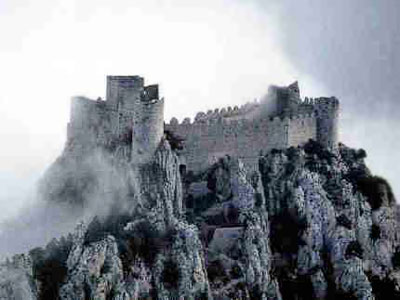
There was a royal tradition through Godfroi and
Boudouin de Bouillon
that is based upon the "Rock of Sion" and that in status equalled
the foremost European dynasties. Both the New Testament and, later,
Freemasonry, maintain that the "Rock of Sion " is the same as
Jesus.
Once the Merovingians had re-established themselves in Jerusalem,
they could better afford to make the facts known. This explains why
the Grail romances, which were associated so closely with the
Knights Templar, started appearing at this time. In time, no doubt,
the full truth of the Merovingian kings would have come out, and
they would have ruled extensively over Europe, replacing the Pope,
and making Jerusalem the capital of the Christian world.
If Jesus
had been accepted as a mortal prophet, a priest-king and the
descendant of the Davidic line, he would also have been accepted by
the Moslems and Jews. That would obviously have changed Middle East
history significantly.
However, this was not the course of history, and the Frankish
kingdom of Jerusalem did not succeed. With the loss of the Holy Land
in 1291, to the Muslims, the Merovingians were sidelined, and the
Knights Templar rendered redundant.
Since that time, the Roman
Catholic Church has continued to strengthen at the expense of the
truth.
Back to Top
|













